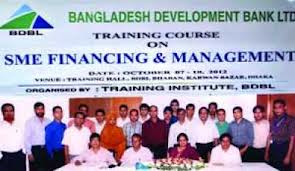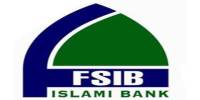History of Bangladesh Development Bank Limited (BDBL):
Bangladesh Development Bank Limited (BDBL) is fully state owned Bank of Bangladesh which came to effective at 3rd January 2010. Bangladesh Shilpa Bank (BSB) and Bangladesh shilpa Rin Songstha (BSRS) were merge into Bangladesh Development Bank ltd (BDBL) at 16th November 2009 and come to effective at 3rd January 2010. In addition commercial Banking, BDBL provides financial and technical assistance to broaden the private as well as public sector industrial base of the country.
It prioritizes, especially, export oriented/export linkage industrial units, efficient import substitution, joint ventures, commercialization of local technology and promotion of agro-based industry.
Bangladesh Shilpa Bank (BSB) and Bangladesh shilpa Rin Songstha (BSRS), with almost similar functions, were established on 31st December, 1972 under the presidential order no. 129to provide loans and facilities to industrial institutions, help failed to meet expectations. In 1992, the government moved to privatize BSRS, which remained unaccomplished due to some complexities, the company’s board sat on December 8 to fix a vendor agreement schedule with the government, the BDBL organ gram, employee pay structure and select office space for the banks headquarter. As per merger plans, the accounts of the two organization’s consolidated by December 2009.
The paid up capital of the merged company will amount to 400 cores. Before merged the paid up capital of BSB was tk. 200 core was tk.70 core for BSRS. Making adjustment to the reserve to the reserve funds of the two companies will raise the capital. In the meaning, BSRS raised its funds to taka. 200 core. As per BDBL operational plans, the bank will operate across the country by setting up branches at district levels. At present, BSB has 15 branches while BSRS has 2.
Vision of BDBL:
To emerge as the country’s prime financial institution for supporting private sector industrial and other projects of great significance to the countries economic development. Also be active participant in commercial banking by introducing new lines of product and providing excellent service to the customer.
Mission of BDBL:
- To be competitive with other Banks and Financial Institution in rendering services ;
- To contribute to the country’s socio-economic development by identifying new and profitable areas for investment ;
- To mobilize deposit for productive investment ;
- To expand branch network in commercially and geographically important places ;
- To employ quality human resources and enhance their capability through motivation and right-type of training at home and abroad;
- To delegate maximum authority ensuring proper accountability ;
- To maintain continuous improvement and up gradation in business policies and procedures ;
- To adopt and adapt to new technology ;
- To maximize profit by strong, efficient and prudent financial performance; and
- To introduce new product lines according to market needs.
Objectives of BDBL:
- Invest in Eco-friendly industries that help mitigate environmental degradation by lending more for renewable energy, and effluent treatment plants and other projects that employ energy efficient low-emission technologies including agro-based industries, small power projects, ICT, transport and infrastructure projects.
- Select and invest industrial projects where location advantages like local availability of raw materials, good infrastructural facilities (road communication, transport facilities, etc.) and utilities (power, gas, water, etc.) shall be available.
- Limit project loan to tk. 15 core maximum and tk. 2 core minimum (for large projects). Arrange and participate in syndicated loan for projects above tk. 15 core.
- Identify prospective and potential entrepreneurs and investors/clients and motivate, guide and help them select profitable industrial venture for investment.
- Regularly publish financial disclosures.
- Undertake from time to time SWOT (Strength, Weakness, Opportunity and Threats) analysis for reviewing bank’s market position.
Institutional Overview:
| Name | : | Bangladesh Development Bank, a state-owned commercial Bank (formed through merger of Bangladesh shilpa Bank and Bangladesh Rin Sangstha) |
| Legal Status | : | Public Limited Company |
| Date of incorporation | : | November 16,2009 |
| Banking license obtained | : | November 19,2009 issued by Bangladesh Bank |
Vendors’ Agreement Signed:December 31, 2009 between the Government and Board of directors of BDBL nominated by the GovernmentFormal Inauguration:January 03,2010Registered Office:BDBL Bhaban, 8, Rajuk Avenue,Dhaka-1000Authorized Capital:Tk. 10000 millionPaid up Capital:Tk. 4000 millionReserve (as on 01.01.2010):Tk. 2270 millionTotal asset (As on 01.01.2010):Tk. 16747 millionTotal Human Resource:781Number of Zonal Office:3Number of Branches Office:17
Sources of Fund:
- paid up capital
- loan from Government of Bangladesh
- Loan from Bangladesh Bank
- Commercial Banks
- Local/overseas Financial Institution
- Suppliers’ Credit.
Ownership of BDBL:
At last 51% of the authorized capital of BDBL be subscribed by Government and remaining 49 percent be subscribed by Bangladeshi nationals or by local or foreign Financial Institution. Presently, 100 percent ownership of the Bank belongs to the Government.
Functions of BDBL:
Bangladesh Development Bank Limited (BDBL) extends term loan facilities in local and foreign currencies to industrial projects (both new and BMRE) in the private and public sectors. Besides, the bank also performs the following the following activities:
- extends term loans by giving special priority to the small and medium enterprises (SMEs) for achieving self- reliance a well as enhancing production and employment including empowerment of women
- provides working capital loans to industrial projects,
- Provides equity support in the form of underwriting and bridge loan to public limited companies.
- Issues guarantees on behalf of borrowers for repayment of loan,
- Extends commercials banking services along with deposit mobilization,
- Purchases and sales shares/securities of enlisted companies for BDBL and on behalf of its customers as member of Dhaka stock Exchange (DSE) Ltd. And Chittagong Stock Exchange (CSE) Ltd. For capital market development,
- Conduct projects promotional activities along with preparation of various subject oral study reports
Board of Directors:
The overall policy formulation and general direction of the Bank’s operation vested in the Board of Directors appointed by the Government. This Board of Directors consists of 9 (nine) members including the Chairman and the Managing Director. The Managing Director is the Chief Officer (CEO) of the Bank.
Human Resources:
A. Job wise Distribution
| SL |
No. Name of the post No01. Managing Director 01.02. General Manager 0603. Deputy General Manager 1704. Assistant. General Manager 3305. senior Manager 6206. Manager 12207. Senior Officer, Librarian/Medical Officer, Sr. Security Officer 145Total class -1 386Total class-2 104Total Officer 490Staff: Class-3 149Class-4 73Total 221Grand Total 781
B. Profession-Wise distribution:
| SL |
Profession No.
No. 01. Phd (Economics) 0102. Phd (MIS) 0103. Professional Accounting (ICMA, FCA, etc) 0404. Engineers (Civil, Mechanical, Electrical, Chemical, Naval, Metallurgical) 0205. IT experts (From Engineers, MBAs, Other Professionals having PGD/Diploma
In computer Science, software Engineering, Computer application, etc.) 1106. MBAs 0907. Economist 5608.Accounting 4809. Finance 0310. Marketing and Management 1211. law Officer 1312. Statistician 1213. Others (Inclusive of Applied Physics, Applied Chemistry and
Other University Graduates and post –Graduates) 499Grand Total: 781
Training & Development of Human Resources:
Banks have a Training Development for upgrading the professional competence and skills of its officers and staff. Below are the main functions of Training Department:
- To prepare and implement Annual Training program.
- To impart training of the officers/staff regarding business and operation of the Bank.
- To adopt measures to hold in-business training and make arrangements to send Bank’s officers to overseas training programs.
- To establish liaison with domestic and overseas organizations relating to training.
- To send officers to local training institutions for improving professional skills, and
- To organize seminar/Workshop/Symposium on key Economic/banking issues.
Risk Management
Risk, to varying degrees, is involved virtually in all types of business of business activities. The financial services proving organizations are not different from this. The risk exposures mainly include credit, market, liquidity, operational, etc.
Bangladesh Banks has identified 5 core risk areas relating operations. These are:
- Credit risk
- Asset and liability/balance sheet
- Foreign exchange risk
- Money laundering risks
- Internal control and compliance risks
In congruence with CRM guidelines of Bangladesh Bank , BDBL prepared 6 sub manual for its compliance.
Corporate Social Responsibility:
The Bank’s functions are not only limited to industrial financing, it is also committed to be known as an institution that builds long term relationship and delivers awards to its clients for regular payment of loans as well as responsible for its employees and communities. The Bank promotes various socio-cultural activities, like picnic, sports, Etc. For gearing and cheering up its employees, financial assistance to the Bank’s employees and financial assistance to the severe ailing employees for proper treatment. Besides, the Bank also donates to charitable institution and government’s relief fund.
Activities of Various Department of BDBL:
Bangladesh Development Bank Limited operates its activities through 22 departments, but out of them I inspected 8 departments to know details about their activities.
Loan Operation Department (LOD):
Loan operation department performs preliminary stages of loan sanctioning procedure. This department scrutinizes the viability of the project. 3 categories functions of loan operation department are :
- security of the loan:
Initially the applicants have to fill up a basic loan application form. When prospective industrialists come to bank of loan they have to fill up a ‘Bank standard Questionnaire’ form. In this stage primary viability of the applicant is Judged. Rejection rate of this stage is around 25 %.
These include the following:
- Name of the project
- Location both office and industry
- Types of product promoters
- Historical data and information of the project.
Scheduled Activities Done by (LOD):
- Provide logistic support and suggestion to the investors relating to industrial loan, application form of loan distribution, project proposal receive and processing and project proposal evaluation and loan recommendation under investment rules and regulations.
- Project loan proposal evaluation/ justification and proposal is sent to land sanction sun-committee to sanction loan and getting approval form respective activity.
- To take necessary Acton to process and approve con-financing projects.
- Clearance letter of investment board in respective project proposal
- Loan sanction letter prepare and sent to respective department.
- Revaluation of past evaluated loan agreement if necessary, according to up-to-date data.
- According to foreign investment authority’s requisition, project evaluation report up date.
- To publish respective notice in terms of changes of govt. Bank rules to loan procurement and sanction in various time.
- Share underwriting proposal processing and approving of bank and other financial institution as a member of ICB consortium.
- Preparation of long term statement about pending proposal and sanctioned project etc.
- Keeping of sanctioned loan project’s feasibility report; sanction letter and sanction memorandum etc.
- Time to time, investment rules deliberation, recommendation and regulation preparation for the same.
- Sales of observation and loan application to Bangladesh live in abroad.
- Advice about preparation loan application form to non-resident people of Bangladesh.
- Take necessary action to prepare application for of loan to be process of sanction.
- Take steps with foreign investors to investment proposal processing and sanction
- Invitation and inspiration of lease financing to foreign investors/entrepreneurs/machinery producing company.
- Keeping of non-resident Bangladeshi and joint investment guarantee statement preparation, memorandum and approved letter.
Project evaluation and apprising :
As a development financial institution BDBL also has separate loan disbursement procedure. A project is a proposal for the new investments, expansion program, develop and update production facilities in a community the overall viability of a project to be financed. An objective assessment of viability of a project is mentioned as a project appraisal. The main objective of project appraisal is to examine and the need of the project, judge whether the project is likely to meet the need and fulfill the requirement in respects of Bangladesh Development Bank Limited. It is an important basis of decision-making because project appraisal gives a clear idea about whole aspect of that project. Although there is no specific standard approach for project appraisal nevertheless numerous and diverse elements can come into the process of appraisal. It is difficult to appraise of certain project sufficiently however should cover as much as possible. BDBL tries to follow some set of scrutinize factors for their evaluation procedure. As a result they are able to overcome some problem and unnecessary time consuming. In practice project appraisal cover different aspects of a project. These are the following:Management and organization aspect
- Technical aspect
- Marketing aspect
- Financial aspect
- Social and economical aspect
Management and organizational aspect :
There is no standard set of rules to identify the borrowers of promoters for new industrial establishment. It is to be done by direct and indirect investigation. The borrowers experience and capabilities can be assessed in terms of his educational background, special qualifications, practical business experience, and receptiveness to new ideas, the general reputation and adaptability to new and changing situation. To some extent it depends on the type of the project and the background of promoters. The competence of the manager and technical executives are also considered. But if such a project is sought to be promoted by a new and inexperienced promoters, all the aspects such as the competence and previous experience of the promoter, their collaboration arrangement, the technical and managerial backing has already line up, their financial resource etc may have to be thoroughly scrutinized.
Credit investigation: The following objects are intended to realize through the credit investigation.
- Identification of applicants who are interested to get loan for industrial establishment.
- Determination of their ability and willingness to abide by their agreement with the bank.
- Evaluation or their capability regarding education, experience, and financial worthiness.
- Justify their objectives and management capabilities to run the business.
- Evaluation honesty, integrity and past records in respect of transaction with the other bank’s and financial institutions.
- Appraisal of management and organization of a project cannot be done without proper justification and undertaking of a methodological credit investigation.
Source of information :
Particular information is necessary to evaluate the credit worthiness of a specific project. There are several methods like written requests, telephone conversation, informal meeting, physical verification and past records. The usual sources of information can be broadly categorized into internal and external sources.
- Internal sources: Details of past borrowings / equity support such as amount, date of sanction, amount repaid, amount outstanding and overdue, together with comments on aspects like replacement etc.
- External sources: Credit information bureau report, interview with the applicants, financial statements, deed and statutory documents investigation of business properties, register of joint stock companies and government publications.
Liquidity position of the applicants
The credit investigation must satisfy that he applicants are financially capable of undertaking a project of the contemplated size. This call for determination of the sources and also the extent the investor is ready to invest.
Capacity measurement of the applicants :
The following factors may be considered in this respect:
- Investigation how successful the application is in their present trade and profession.
- Judge whether they are financially and managerially competent to undertake and implement the project.
- Analysis of the past operations, opinion of the commercial bankers,
Independent opinion from outside sources etc.
- Past repayment performance of existing loans.
Technological aspects;
The technical aspects encompasses whether the project is sound with regard to every engineering and technological consideration. The evaluation of the cost of resources in monetary term to determine the capital cost of the project and also its operating cost after implementation are considered. While evaluating the capital outlay and physical facilities, the engineer will have to determine the production cycle and also the time schedule fir implementation of the project. In the case of a project evolving technical collaboration or borrowed technology, the project engineer has to examine various facts of technology and its adoption to the local conditions including technology transfer and financial and economic implications of such transfer of tech enology. A development bank like BDBL may need to consult or contact specialize engineering services from outside for specialized matters, particulars relating to projects to be based on complex technology. Any decent in the project design and formulation will eventually affect the enterprise adversely. The following factor should be considered:
- Preliminary investigation : Products and services, raw materials, skill manpower and technology required for manufacture the product and services and testing analytical report.
- Selection of production process : choice of alternative and selection criteria, wastage in manufacturing process, by products and their recovery, disposal of wastes and effluents and environment pollution control.
- Productivity and site selection: technical factors cost factors of production marketing factors, administrative and housing factors and transportation factors.
- Lay out of plan: site selection far building, plant and machinery and supplementary
Installations, estimation and evaluation of cost.
- Work schedule and evaluation of utilities and supplies: raw materials, stores and spares, technical know-how, transfer of technology, power, fuel water, steam, labor and transporting.
Marketing appraisal: market analysis is the first screening stage in the project appraisal, at which project that cannot expect satisfactory market acceptance shall be rejected. For appropriate marketing objective, it is necessary look at depth unto the macro / micro demand / supply situation for specific products the market, existing and expected competition in local and foreign markets, the market share etc. while appraising industrial projects, the bank is required to analyses these factors and to bring out the objective in quantitative terms. The following factors also are considered:
- Product identification: considerable factors are nature of demand, types of demand, size and composition of present demand.
- Consumer markets: administrative regions, geographic regions, climate, and city-size, rural-district cut-size.
- social status: icon (level, dynamic, distribution), age, sex, occupation, family size, religion, income elasticity of demand, prices and availability of complementary goods, nationality, social class, culture etc
- Personality and behavior : life style, leadership, ambition, conservatism, buying motive, loyalty, extroversion and introversion, service sensitivity and promotional sensitivity
- Number and types of industrial users : Size of the project, ownership, and age of equipment, regional concentration, vertical vs horizontal markets and technological progress
- Market accessibility : Tariffs and fees, non-tariff barriers like quality standards, health medical and safety requirements, package standards, import quotas, customs regulations and political and administrative barriers and trading habit
- Supply analysis : Past and present output, determine the projects position in the market and thus expected, domestic producers present and projected capacities, new projects being under construction, present and projects export volume, foreign manufacturer capacities marketing strategies and development plans and government policies
Financial appraisal: The purpose of financial appraisal is to assess whether the proposed project is viable in term of its operation in the future years and its financial soundness. The financial appraisal is performed for the following:
- Fund requirement: To bring the project into existence and the probable sources form which the required funds will be mobilized.
- Revenue generation: Financial analyst also assess about prospect revenue generation that is actual cash generation and its probable impact upon the financial condition.
- Cost of the project: The cost of a project represents all capital expenditure to be incurred for acquisition of its fixed assets plus the net contribution of long-term resources in the proposed current assets. In other worked, the fixed cost of the project plus the net working capital requirement to run the project will comprise its total cost. The analyst should assess various costs relating to the fixed assets. The fixed cost of a project is the aggregates of cost of land, building construction, plant, machinery and equipments, etc. working capital is necessary for investment in current assets like stocks of raw materials, goods – in- process. Finished goods, stores and spares, debtors etc. working capital requirement depending on the nature of the project, which should be followed during appraisal.
- Financial statement analyst: The ratio analysis one of the most important tools for financial statement analysis. Four basic categories for ratios are as follow :
- Liquidity ratios
- Leverage ratios
- Profitability ratios
- Management efficiency ratio
- Liquidity ratios: Liquidity ratios are designed to measure the ability of the concern to meet it immediate and maturing debt obligations, leverage ratios measure the extent of funds contributed by the owners of the project as capital aompard to the funds provided by its long-term creditor.
- Profitability ratios: It shows the management overall effectiveness as revealed by the returns generated on sales and investment.
- Management efficiency ratio : It is for the evaluation of management performance
- Cost of the production: This process involves preparation of some sort of expenses budgets for the relevant years for which sales have been calculated all the expenses can be broadly divided into the following three categories.
- Cost of good sold.
- General and administrative and selling expenses, and
- Financial expenses.
Socio-Economic Appraisal
Economic appraisal is the primary means of determining whether a proposed investment is worthwhile or not.
a) Qantifable factor :
Economic appraisal should cover both quantifiable and non-quantifiable factors. The quantifiable factors include the followings:
- Economic rate of return (ERR)
- Domestic resources cost
- Contribution to gross domestic product and
- Employment generation etc.
Economic rate of return (ERR): Economic rate of return measure the potential earning power of the social resources used in the project and thus helps the assessment of investment proposal.
Decision criteria:After working out the ERR, it should be compared with the accounting rate of interest (ARI). The ARI is nothing but the opportunity cost of capital, which is supposed to maximize the use and productivity of invested resources in the country. The board decision is that, if other things being equal, the project that’s ERR is less than the ARI should ordinarily be rejected unless other non-quantifiable benefits are adequate or the project can be qualitatively justified.
Domestic resource cost: It indicated the domestic resource cost involved for foreign exchange to be earned by a project.
Contribution to gross domestic product (GDP): Contribution to GDP of a project is estimated from sales value and inter-firm transactions. Data regarding sales value is taken form the calculation of sales estimate of the financial appraisal.
Employment generation : The number of full-time jobs measured in man-years expected to be created both during construction and during operation of the project should be estimated separately. If data are available, these estimates should be related to regional, sect oral and national levels of unemployment and under employment.
b) Non-quantifiable/intangible/Externalities :
The non-quantifiable factors refer both the following :
- To effects that are known to arise but which cannot be measured in physical term and
- To effects which cannot be valued, difficulties problems often are date problem.
Documentation Machinery & Procurement Department:
The main activities of documentation department are the following:
- Documentation and contract completion with loan receiver after loan sanction.
- Document given by company to bank or document for land evaluation and investigation
- Site conformation about land/project according to document and making the law by govt. survey or if necessary.
- Examination of project memorandum and statements of affairs.
- Change filing at company register office of mortgage land.
- Re-newel of necessary document in time.
- Conformation of bank guarantee from debtor and \keeping it properly and renewal before expired of due time.
- Actual document collection form register and act as custodian for that documents.
In a narrow point of view machinery procurement is to help the organization to acquire the machinery form local or foreign countries. So after completion of documentation the below mentioned functions are also done by documentation and machinery procurement department:
- Machinery schedule preparation/ selection and approving for tender.
- Necessary advice given to investor’ entrepreneur about tender invitation to collect project machinery.
- Offering machinery and related document evaluation and necessary information collection about supplier.
- Com
- Preparation of rules and regulation of related machinery procurement.
- Information collection about different price of machinery of different capacity in industrial production.
- Recommendation about various project regulated by loan separating department and zonal office
Machinery Procurement Policy of BDBL
|
|
| Cost range Officer Empowered |
| Shopping Method : |
| 01. Up to US $ 0.015 Million Head of the Department ( related to machinery |
Procurement)02. Up to US $ 0.025 million Head of DivisionQuotation / Tender Method :01. Up to US $ 0.01 million Head of the Department02. Up to US $ 0.05 million Head of Division03. Up to US $ 0.010 million Managing Director04. Above US $ 1.00 million Board of Directors
| REQUIREMENT OF PAPERS AT THE TIME OF APPRIASAL AND PROCUREMENT |
A. Imported Machinery
1.Each offer should mention/submit :
- Detail technical specification
- Detail terms and conditions
- Delivery schedule ( maximum 180 days )
- Catalogues
- Manuals
- Drawings
- Manufacturers recommended square parts
- Price in CFR Khulna/ chittagong./ Dhaka/ Benapole basis ( showing FOB and freight separately )
2. The offer should be concluded in US $ basis as well as currencies of the country of origin.
3. The offer should contain the clause that all negotiating Bank Charges at supplier have to be borne by the suppliers.
4. If the offer submitted by the local agent, the agent should submit :
- Photocopy of the Agency Agreement with the overseas principal.
- Registration no of CCI and E.
- Indenting Association registration number.
- Permission number of Bangladesh Bank
- Commission in the invoice
5. The supplier/manufacturer must furnish the name and countries to which similar machinery has been exported by them indicating the volume of exports in last three years.
6. The supplier/manufacturer should also submit the following :
- Latest audited Balance sheet.
- Constitution of the company
- Letter of authority to BDBL hereby BDBL ask for confidential report/opinion from the designated Bank (Account no. to be provided by the company).
- Letter of recommendation or certificate from the National Chamber of commerce and industry or Government responsible for export.
7. The manufactures/suppliers should Provided drawing and technical documents for use in the machinery layout foundation, installation and supervision of the machinery.
8. The manufacturer/supplier will guarantee the production as per claimed production capacity.
9. The manufacturer/supplier should also mention the following :
- Life expectancy of machinery.
- Spare parts and accessories for two years of operation with price in FOB and freight separately.
- After sales services facility to be provided by them to the users of machinery.
10. The manufacturer/supplier if selected required to :
- Enter into a contract with the buyer as per BDBL’s proforma.
- Submit 15 % performance Bank Guarantee as per BDBL’s proforma or accept the conditions of 15 % tetention money or combination of both.
- Submit guarantee and warranty certificate as per BDBL as per BDBL’s proforma be countersigned by manufacturer.
B. Local Machinery
1. Each offer should mention/contain.
- Detail technical specification.
- Detail terms and conditions.
- Delivery schedule (maximum 120 days from placement of order).
- Validity (120 days).
- Catalogues.
- Manuals.
- Drawings.
- Manufacturers recommended spare parts.
- Price (ex-factory).
2. The supplier/manufacturer must furnish the name and countries to which similar machinery has been exported by them indication the volume of exports in last three years.
3. The suppler/manufacturer should also submit the following :
- Latest audited Balance sheet.
- Constitution of the company.
- Letter of authorities to BDBL whereby BDBL may ask for confidential report from the designated Bank (Account no. to be provided by the company).
4. The manufacturer/suppliers layout foundation, installation and supervision of the machinery.
5. The manufacturer/supplier wills guarantee the production as per claimed production capacity.
6. The manufacturer/supplier should also mention the following :
- Life expectancy of machinery.
- Spare parts and accessories for two years of operation with price in FOB and freight separately.
- After sales services facility to be provided by them to the users of machinery.
7. The manufacturer/supplier if selected required to :
- Enter in to a contract with the buyer as per BDBL’s prescribed proforma.
- Submit 10 % performance Bank Guarantee as per BDBL’s proforma or accept the conditions of 10 % retention money.
Project Implementation Department:
Project implementation department plays a crucial role for implementing the project. All sorts of monitoring activities performed by project implementation department, such as placement of machinery, technical and mechanical side, and acquiring new instruments, some time this department investigates the viability of project. Besides these below mentioned activities are also done by this department:
- To take necessary action in favor of sanctioned loan to be implemented.
- To take steps to approve project layout plan.
- Change of project location, board of director of company and producible goods and product mix.
- Take steps to disburse sanctioned loan step by step according to loan condition.
- Properly collection and disbursement of entrepreneur fund.
- Inter-organizational communication and support about bride loan against share underwriting of loan Holder Company.
- Completion of construction of project according to construction timetable.
- Proper monitoring of placement machinery in project area.
- Re-auditing of cost at project completion stage, re-examining of excess loan application and processing of loan application and sanctioning, disbursement and conformation of uses.
- Evaluation of project raw material receiving process, managing of cash flow according to loan agreement and giving necessary support.
- Preparation of project completion report and sent if to loan recovery department and related sub-division of authority.
- Determination of construction period, schedule preparation of loan repayment and taking necessary action for the same.
- Smoothly supervision and monitoring of project at implementation time.
- Taking insurance scheme against risk of assets of implementing project and conformation of deposit of insurance premium to the bank.
- Time to time verification of latest rules and regulations about project completion and appropriate rule preparation.
- Final construction reports preparation and at least two installment of loan repayment conformation after project completion.
- Talking legal action, if loan receiver rare unable to repay loan’s two installment after remind him/them.
Central Recovery Department:
Central recovery department is responsible for recover money form Dhaka form Dhaka district. Success or failure of Bangladesh Development Bank Limited is dependent on this department. The performance of central recovery department is not better today.
The main function of central recovery department is the following:
- Make proper communication with loan holder to accelerate loan payment/recovery.
- Proposal for excess loan/BMRE to existing project and processing, sanctioning and implementation with the approval of loan operation department for that project.
- Processing and implementation of loan rescheduling.
- Information provide to branch central department about progress of loan repayment and other for the same.
- Observation of progress of project, investigation according to instructed schedule, maintaining, informed about arising problem and taking respective decision for the same.
- Arrangement of insurances policy against projects assets and to up date of insurance for the same.
Loan Accounting Department:
Loan accounting department particularly covers accounting side of the Bangladesh development Bank limited. The other functions of Bangladesh Development Bank Limited (BDBL) are the following:
- Keep records of local and foreign loan affairs of bank financial project.
- Loan classification/reclassification according to lean agreement prepared by loan operation, loan recovery, loan rehabilitation, zonal and branch and law department along with proper authority’s approval.
- Provide information about project loan accounts to loan holder, related bank authority, departments, zonal and branch office regularly.
- To provide relevant accounting information to project entrepreneur, related bank department, zonal and branch office about recoverable loan installment, interest of loan etc.
- Keeping loan recovery statistics, submission of statistics to inform management authority and other related department.
- Preparation of loan statement schedule and supply that information to various department and branch office is monthly and quarterly basis.
- Make information about yearly loan statement and up dated loan statement to loan order.
- Loan account scheduling according to loan disbursement.
- Keep all loan accounts and submit trial balance to central accounting department in monthly basis.
- Re-evaluation of existing loan accounting method and correction, refurnishing and to update the methods.
Significant Accounting policies of Bangladesh Development Bank Limited
- General Plocies: In preparing the accounts, the going concern concept has been adopted and historical cost method used as the measurement base. Accrual accounting is used to match income and expenses.
- Share capital : The authorized capital of the bank is two billion taka divided into two million shares of one thousand each of which sixty six percent is subscribed and paid-up by the government and the remaining thirty-four percent shares may be subscribed for by Bangladeshi national or by any financial institution, Bangladeshi or foreign.
- Consolidation of accounts : A separate set of records for consolidation the trial balance of the branch offices and loan accounting department is maintained at the central accounts department head office form which financial statement of the bank are drawn-up
- Foreign currency transaction: foreign currency balances of various accounts as on 30th June 2007 have been translated into taka at the rates prevailing on the balance sheet date.
- Fixed assets: fixed assets are stated at cost less accumulated depreciation.
| Particular | Rate of depreciation |
| Building and premises | 2.5% |
| Furniture and fixture | 10 % |
| Electric/gas installation | 20 % |
| Typewriter, ceiling fans, office equipments | 20 % |
| Motor cars, other vehicles | 20 % |
Project Rehabilitation Department:
Rehabilitation department was mainly established to deal with sick industry. They find out the causes of sickness of a particular project. Some time they reschedule loan according to the capabilities of the project. If the project is not rehabilitable, Send to the law department and finally sued against the project. The main activity of rehabilitation department is the following:
- To take action to rehabilitate sick project after appropriate investigation.
- Document transmission to law department about the project that would not under rehabilitation.
- To take steps about rehabilitation document examination, recommendation preparation, implementation, schedule preparation and activation of plan.
- Rehabilitation program preparation, management control and ensuring of management of the project that could manage by bank.
- Take necessary action about production, marketing of product and loan repayment.
- Managing and directing recommendation preparation about take over project.
- Conformation project profitability of joint project.
- After successful managing of project, duties give up to third party previous management.
Human Resource Department:
This department deals with 5 sections
- general and administration policy section
- Management section
- welfare section
- Leave section
- Disciplinary section
HR department does the below mentioned activities with the co-operation of the above mentioned 5 departments:
- To control the administration of human resource we of the bank.
- To assess and collect compatible personal who will be perfect for the bank.
- To maintain relationship with government and other financial institutions.
- To take program and implementation for developing human resources
- To make appointment, to promotion and apprising skill of officer and stuff
- To make service rule correction expansion, administration rules sub rules orders notice etc for controlling stuff
- To provide scholarship to the brilliant of the stuffs
- To communicate with trade union scrutinizing their demands open discuss.
















